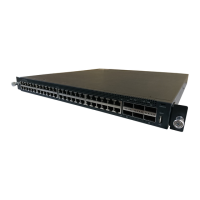User’s Guide FUJITSU PSWITCH
December/2018 67
MMRP is a protocol that defines that a MRP Application provides the group
membership or individual MAC registration service. Like IGMP snooping, MMRP
helps control the flooding of multicast packets. MMRP-enabled switches
dynamically register and de-register group membership information with the MAC
networking devices attached to the same segment. MMRP also allows group
membership information or individual MAC information to propagate across all
networking devices. This is achieved by using MRP to propagate attributes. This
feature only support on physical port interface and LAG.
3.1.2.8. STP (Spanning Tree Protocol)
Spanning Tree Protocol (STP) is a layer 2 protocol that provides a tree topology for
switches on a bridged LAN. STP allows a network to have redundant paths without
the risk of network loops. STP uses the spanning-tree algorithm to provide a single
path between end stations on a network.
The switches (bridges) that participate in the spanning tree elect a switch to be the
root bridge for the spanning tree. The root bridge is the switch with the lowest
bridge ID, which is computed from the unique identifier of the bridge and its
configurable priority number. When two switches have an equal bridge ID value,
the switch with the lowest MAC address is the root bridge.
After the root bridge is elected, each switch finds the lowest-cost path to the root
bridge. The port that connects the switch to the lowest-cost path is the root port on
the switch. The switches in the spanning tree also determine which ports have the
lowest-path cost for each segment. These ports are the designated ports. Only the
root ports and designated ports are placed in a forwarding state to send and
receive traffic. All other ports are put into a blocked state to prevent redundant
paths that might cause loops.
To determine the root path costs and maintain topology information, switches that
participate in the spanning tree use Bridge Protocol Data Units (BPDUs) to
exchange information.
3.1.2.8.1. STP (Spanning Tree Protocol)
Spanning Tree Protocol (IEEE 802.1D) is a standard requirement of Layer 2 switches
that allows bridges to automatically prevent and resolve L2 forwarding loops. The
STP feature supports a variety of per-port settings including path cost, priority
settings, Port Fast mode, STP Root Guard, Loop Guard, TCN Guard, and Auto Edge.
These settings are also configurable per-LAG.

